From F. J. Cohn1 4 October 1874
Schweidnitzer Stadtgraben Nro. 26. | Breslau
4 Oct. 1874.
Verehrter Herr
Mit inniger Freude hat mich der liebevolle Brief erfüllt, den ich von Ihnen erhalten habe;2 es gereicht mir zur höchsten Genugthuung, dass es mir vergoennt war, zur Vervollstaendigung Ihrer so merkwürdigen Forschungen beizutragen. Ich würde überhaupt nicht gewagt haben, meine Beobachtungen über Aldrovanda und Utricularia zu publiciren,3 wenn ich nicht geglaubt haette, dass Ihnen diese Pflanzen unzugaenglich seien, was allerdings, wie ich sehe, nur bei der ersteren der Fall war. Wäre es nicht jetzt zu spaet in der Jahreszeit, so würde ich Ihnen lebende Aldrovanda zugeschickt haben; doch sind jetzt nur Winterknospen vorhanden; im naechsten Sommer will ich mir erlauben Ihnen frische Exemplare zur Vergleichung zu übersenden. Aldrovanda ist in der That eine Dionaea “en miniature”, und zwar nicht blos nach dem äussern Ansehen, sondern auch nach dem anatomischen Bau; so sind zum Beispiel die Trichome auf der Innenseite der Blaetter von Aldrovanda didynamisch, ähnlich wie in den Schläuchen von Utricularia;
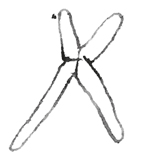 bei Dionaea sind dieselben tetradynamisch;
bei Dionaea sind dieselben tetradynamisch;
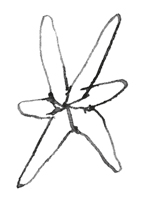 oder achtarmig; die Drüsen von Aldrovanda bestehen, von oben gesehen, aus zwei concentrischen Reihen;
oder achtarmig; die Drüsen von Aldrovanda bestehen, von oben gesehen, aus zwei concentrischen Reihen;
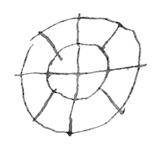 die von Dionaea aus drei solchen Reihen;
die von Dionaea aus drei solchen Reihen;
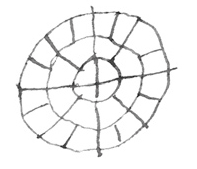 die Randborsten von Aldrovanda sind einzellig;
die Randborsten von Aldrovanda sind einzellig;
 die von Dionaea vielzellig, u.s.w.4 Ich erlaube mir dabei zu bemerken, dass ich die anatomische Untersuchung von Dionaea, namentlich mit Rücksicht auf den Mechanismus ihrer Bewegung begonnen, jedoch mich nicht berechtigt gehalten habe, darüber etwas zu veroeffentlichen, weil ich voraussetzte, dass Sie selbst, oder Dr. B. Sanderson bereits diese mikroskopischen Untersuchungen zu publiciren in Begriff sind;5 nur im Fall von Ihnen die mikroskopischen Verhaeltnisse nicht mit in den Kreis Ihrer Forschungen gezogen sein sollten, würde ich es wagen, meinerseits darauf zurückzukommen.
die von Dionaea vielzellig, u.s.w.4 Ich erlaube mir dabei zu bemerken, dass ich die anatomische Untersuchung von Dionaea, namentlich mit Rücksicht auf den Mechanismus ihrer Bewegung begonnen, jedoch mich nicht berechtigt gehalten habe, darüber etwas zu veroeffentlichen, weil ich voraussetzte, dass Sie selbst, oder Dr. B. Sanderson bereits diese mikroskopischen Untersuchungen zu publiciren in Begriff sind;5 nur im Fall von Ihnen die mikroskopischen Verhaeltnisse nicht mit in den Kreis Ihrer Forschungen gezogen sein sollten, würde ich es wagen, meinerseits darauf zurückzukommen.
Was nun die kleine Abhandlung betrifft, welche Sie so gütig aufgenommen haben, so hat dieselbe folgende Geschichte. Als ich Anfang August die überraschenden Beobachtungen über Aldrovanda und Utricularia gemacht, in Folge der in “Nature” enthaltenen Abhandlung des Dr. Sanderson,6 welche mich zur Prüfung auf das Lebhafteste angeregt hatte, da war es zuerst meine Absicht dieselben in einem, an Sie gerichteten Sendschreiben bekannt zu machen; doch überzeugte ich mich, dass in dieser Form nicht jene Ausführlichkeit zulässig sei, welche die bisher nur wenig genau erforschte Organisation der “Fallen” bei desen Pflanzen mir zu erfordern schien; ich entschloss mich daher meine Beobachtungen zu einem Aufsatze zu verarbeiten, den ich in das eben in Druck begriffene dritte Heft meiner Beitraege zur Biologie der Pflanzen (Breslau 1874. Max Müller) aufnahm.7 Von diesem Aufsatze ist bis jetzt erst der erste halbe Bogen gedruckt; der Bogen, welcher den Schluss meines Aufsatzes enthaelt, ist noch nicht abgedruckt, weil die darauf folgende Abhandlung noch nicht hat gesetzt werden können; ich bin deshalb genöthigt gewesen, von diesem Schluss Ihnen erst einen Bürstenabzug einzusenden, behalte mir jedoch vor, Ihnen ein vollständiges Exemplar zuzuschicken, sobald die Tafel, die noch in Arbeit ist, vollendet sein wird. Einstweilen gestatten Sie mir ein Paar kleine Skizzen aus meinen Zeichnungen über Aldrovanda beizulegen.8
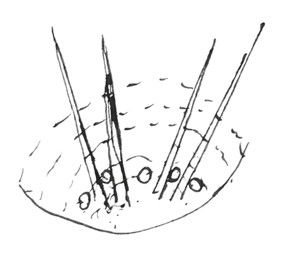
In Bezug auf Utricularia ist Ihre Beschreibung mit der meinigen nicht im Widerspruch; auch ich fand vier Kegelborsten, spines (beiderseits je zwei, vom Centrum der concentrischen Zellordnung des Gaumens gerechnet) und ebenso je zwei, also zusammen vier Borsten an beiden Seiten des untern Peristomrandes.
Ich bin glücklich, dass die nicht eben leichte Untersuchung des Peristoms von Utricularia in Ihren Forschungen Bestätigung findet; haette ich geahnt, dass Sie selbst bereits Utricularia untersuchen, so würde ich nicht gewagt haben mit meinen Beobachtungen hervorzutreten.9
In der botanischen Section der so eben hier abgehaltenen Deutschen Naturforscherversammlung habe ich mir am 22 Sept. erlaubt einen Vortrag über Aldrovanda und Utricularia zu halten,10 wobei ich auch durch gütige Bewilligung des Professor Goeppert11 das Verhalten von Dionaea zu Fliegen demonstriren konnte, und auch auf den inzwischen mir bekannt gewordenen Vortrag des Dr. Hooker “on the carnivorous habits of plants, Nature 3. Sept.”12 Bezug nahm.
Mit lebhaftester Spannung sehe ich dem gütigst in Aussicht gestellten Buche entgegen;13 möge Ihre Gesundheit Ihnen gestatten, recht bald uns wiederum durch jene Belehrung und Anregung zu erfreuen, welche die unbegrenzte Schaar Ihrer Schüler und Verehrer hier in Deutschland, wie in der ganzen wissenschaftlich Welt von Ihnen in so überreichem Masse erhalten, und noch fort und fort von Ihnen erwartet.
Verehrungsvoll | Ferdinand Cohn
Footnotes
Bibliography
Burdon Sanderson, John Scott. 1881. On the electromotive properties of the leaf of Dionæa in the excited and unexcited states. [Read 15 December 1881.] Philosophical Transactions of the Royal Society of London 173 (1882): 1–55.
Insectivorous plants. By Charles Darwin. London: John Murray. 1875.
Translation
From F. J. Cohn1 4 October 1874
Schweidnitzer Stadtgraben Nro. 26. | Breslau
4 Oct. 1874.
Esteemed Sir,
The very kind letter that I received from you has filled me with deep joy;2 it gives me the greatest satisfaction to have been granted the opportunity to contribute to the completion of your so remarkable studies. I never would have dared to publish my observations on Aldrovanda and Utricularia,3 had I not believed that you have no access to these plants, which however, as I see, was the case only with the former. If it were not too late in the season, I would have sent you a live Aldrovanda; but at the moment only winter-buds are available; next summer I will take the liberty of sending you fresh specimens for comparison. Aldrovanda is indeed a Dionaea “en miniature”, in fact not only in its external appearance, but also in its anatomical structure; for example the trichomes on the inside of the leaves of Aldrovanda are didymous, similar to the bladders of Utricularia;
 in Dionaea these are quadrifid;
in Dionaea these are quadrifid;
 or eight-armed; seen from above, the glands of Aldrovanda are made up of two concentric rows;
or eight-armed; seen from above, the glands of Aldrovanda are made up of two concentric rows;
 those of Dionaea of three such rows;
those of Dionaea of three such rows;
 in Aldrovanda, the bristles on the rim are unicellular;
in Aldrovanda, the bristles on the rim are unicellular;
 those of Dionaea multicellular, and so on.4 I might also add here that I had begun my anatomical analysis of Dionaea, in particular the mechanism of its movements, but that I had not felt entitled to publish on this, for I assumed that you yourself or Dr. B. Sanderson were already in the process of publishing these microscopical analyses;5 only if the study of microscopical conditions did not fall within the purvue of your research would I dare to return to them myself.
those of Dionaea multicellular, and so on.4 I might also add here that I had begun my anatomical analysis of Dionaea, in particular the mechanism of its movements, but that I had not felt entitled to publish on this, for I assumed that you yourself or Dr. B. Sanderson were already in the process of publishing these microscopical analyses;5 only if the study of microscopical conditions did not fall within the purvue of your research would I dare to return to them myself.
As regards the small treatise, which you received so favourably, its history is the following. In the beginning of August, after Dr. Sanderson’s treatise in “Nature”6 very much inspired me to examine this matter, I observed the astonishing features of Aldrovanda and Utricularia, which I initially intended to make known in a letter addressed to you; but I convinced myself that this form would not allow the detail that the organisation of the “traps” of these plants, which until now have hardly been researched, to my mind seemed to require; I therefore decided to work up my observations for a paper, which I included in the third number of my contributions to the biology of plants (Breslau 1874. Max Müller), which has just gone to press.7 Only the first half of this article is now printed; the sheets that contain the conclusion of my essay are not yet printed because the following treatise could not yet be set; I have no choice but to send you a galley proof of this conclusion, for the time being, but I reserve the right to send you a complete copy as soon as the table, which is still being worked on, is completed. In the meantime permit me to enclose a couple of small sketches from my drawings of Aldrovanda.8

Regarding Utricularia, your description does not contradict mine; I also found four cone bristles, spines (two each on both sides, starting from the centre of the concentric cell-pattern of the membrane) and likewise two each, and thus altogether four, bristles on both sides of the lower rim of the peristome.
I am glad to find that this by no means easy analysis of the peristome of Utricularia is confirmed by your own examination; had I known that you yourself were already analysing Utricularia, I never would have dared to put forward my own observations.9
In the botanical section of the meeting of German naturalists which has just been held here, I took the liberty of giving a presentation on Aldrovanda and Utricularia on 22 Sept.;10 on this occasion through the kind permission of professor Goeppert11 I was able to demonstrate the action of Dionaea with flies, and I had also the opportunity to refer to Dr. Hooker’s paper “on the carnivorous habits of plants, Nature 3 Sept”12 which had come to my attention in the meantime.
I am looking forward with keen anticipation to the book which you so kindly promised me;13 may your health permit that you will very soon delight us again with the instruction and the stimulation which the vast band of your disciples and admirers here in Germany, as indeed in the entire world of science, has already received from you in such abundance, and which it will expect from you again and again.
Respectfully | Ferdinand Cohn
Footnotes
Bibliography
Burdon Sanderson, John Scott. 1881. On the electromotive properties of the leaf of Dionæa in the excited and unexcited states. [Read 15 December 1881.] Philosophical Transactions of the Royal Society of London 173 (1882): 1–55.
Insectivorous plants. By Charles Darwin. London: John Murray. 1875.
Summary
An account of his observations on Aldrovanda and Utricularia.
Sends CD his memoir on Aldrovanda [Beitr. Biol. Pflanz. 1 (1875) Heft 3: 71–92] in advance of publication [see Insectivorous plants, pp. 321 et seq., 395–6].
Letter details
- Letter no.
- DCP-LETT-9667
- From
- Ferdinand Julius Cohn
- To
- Charles Robert Darwin
- Sent from
- Breslau
- Source of text
- DAR 58.1: 95–6
- Physical description
- ALS 4pp (German)
Please cite as
Darwin Correspondence Project, “Letter no. 9667,” accessed on 18 April 2024, https://www.darwinproject.ac.uk/letter/?docId=letters/DCP-LETT-9667.xml
Also published in The Correspondence of Charles Darwin, vol. 22


